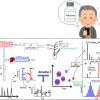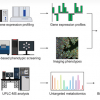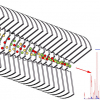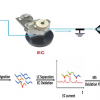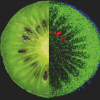Atomic clusters are found between single atoms and solids. Their properties differ from both and depend on their size. Physical properties can change smoothly, and sometimes suddenly, with increasing numbers of atoms, which is the subject of ongoing research. Dr Paul Fischer from the University of Greifswald’s Atomic and Molecular Physics Group has investigated the size dependence of properties of bismuth and indium clusters with novel techniques of multi-reflection time-of-flight mass spectrometry. The experiments constitute the first realisation of tandem multi-reflection time-of-flight mass spectrometry, in which two spectrometry stages are combined in sequence. First, the mass spectrometer is used to select clusters according to their size; then, reaction products are analysed following laser excitation.
“In a first series of measurements, Dr Fischer determined the dissociation behaviour of bismuth clusters as a function of the product size. He then ‘doped’ the clusters with lead, meaning a single lead atom was attached to the bismuth clusters. The interesting question was which bismuth fragments would retain the lead atom upon dissociation. Both steps, the cluster selection and reaction-product analysis, were performed with multi-reflection to attain a high mass-resolving power. In a subsequent experiment, Dr Fischer studied the time-resolved dissociation of indium clusters to gain insight into the conditions of their production through the laser irradiation of a target surface. The details of cluster production are still subject of ongoing research”, reports Professor Dr Lutz Schweikhard, head of the Atomic and Molecular Physics Group.
To allow ions to travel long distances even in a laboratory environment, in Greifswald’s setup, they are reflected back and forth several thousand times between ion-optical mirrors, increasing the mass resolving power to values of several hundred thousand. Additionally, the MR-ToF mass spectrometer can be used as an ion trap, making it possible to track the decay of the clusters over their laps between the mirrors. Thus, cluster dissociations can be investigated in a time-resolved fashion, as the present research demonstrates, enabling further conclusions about the particles’ properties.
The MR-ToF mass spectrometer is one of several that have been developed and built at the University of Greifswald. It has now been used successfully to investigate atomic clusters, leading to several publications, most recently in Physical Review Research (doi.org/fhtn). More specifically, it is based on the experience from an instrument delivered to the precision mass spectrometer ISOLTRAP at the European research facility CERN. The instrument at CERN is used for the detection and selection of exotic nuclei and the determination of their binding energies.




